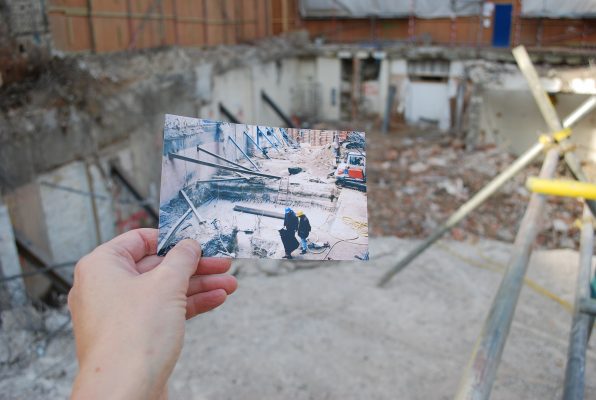In 1498 the colonial explorer Vasco da Gama reached Kerala, on the West Coast of present-day India. The Portuguese first came as traders, but soon moved to consolidate their rule of the region in order to ensure a monopoly over the profitable spice trade. The writings of early settlers in Kerala offer a historical account of the ‘varna’ system – an endogamous, hereditary hierarchy sanctioned by key Hindu religious texts. The varna system was premised on the inheritance of occupation from parent to child, whereby menial and ritually polluting roles that involved dealing with human waste and corpses were performed by those at the bottom of the hierarchy, often in exploitative arrangements with those at the top. This hierarchy pervaded all aspects of social life: touching, dining, marriage, access to education, public spaces, land and even water were circumscribed by one’s position within the system. In the Book of Duarte Barbosa, written in 1516, Duarte Barbosa, a Portuguese commercial agent and interpreter, termed this system ‘casta’, meaning breed or lineage. In an attempt to define the varna system, writers such as Barbosa drew from anti-Semitic ideas of bloodline purity, which were then pervasive in the Iberian Peninsula.
The term ‘caste’ thus has its roots in the persecution and pathologising of Jewish people during the Black Death of 1348, and in the anti-Semitic pogroms of 1391 in Spain, events which resulted in the mass conversion of Jewish people into Christianity. The old Christians viewed the new converts, the ‘conversos’, with scepticism. In the mid-fifteenth century, the Spanish Court of Inquisition installed blood purity (limpieza de sangre) laws, which decreed that any Christian with a Jewish ancestor was a converso, and thus restricted from holding prominent trade or political positions; these laws form the foundation of racial anti-Semitism in the Western world. Spanish colonialists fashioned similar racial hierarchies in the Americas, based on typologies of mixed-race individuals. In the subcontinent, the Iberians identified their own colonial practices of race-making: of creating, classifying and institutionalising difference.
The act of comparing, in the words of American sociologist C. Wright Mills, is ‘making the familiar strange’. This is the premise of Isabel Wilkerson’s book Caste: The Origin of Our Discontents (2020), which takes us through three systems of social hierarchy: the South Asian caste system, Nazism in Germany and race in the United States. Wilkerson argues that German Nazism and the racial system in the United States are premised on the same logic as the Indian caste system. It is productive to discuss these systems together: to examine them in conjunction is to see how they vary and converge, based on their specific historical and geographic contexts as well as their founding logics. By examining how identity-based difference is repeatedly forged and institutionalised into hierarchies, Wilkerson’s work expands our broader understandings of social inequality as it manifests across time and place.
Caste builds on Wilkerson’s Pulitzer Prize-winning book The Warmth of Other Suns (2010), which examined the twentieth-century Great Migration of Black families from the American South to the North, in a futile attempt to escape racism, which was proven to be ubiquitous in American life. Wilkerson, who is a journalist, explains how she spent fifteen years researching the Jim Crow era and still never used the word ‘racism’ in her book, because she felt it was an inadequate term: in its contemporary popular usage, she argues, the word focuses on individuals rather than systems. Rather, Wilkerson sets out to look at structures that enable, reproduce and reinforce racial segregation and exploitation: ‘I wanted’, she writes, ‘to understand the origins and evolution of classifying and elevating one group of people over another.’ Caste is the product of this exercise, consisting of a mix of historical examples and personal anecdotes, interwoven with an analytical examination of both race and caste. For Wilkerson, the contemporary United States is like a 400-year-old house whose structure is built on the ‘unseen skeleton’ of caste: her central argument is that race is not a complex enough framework to understand contemporary inequalities in the US.
Wilkerson draws from, and revives, early sociological scholarship from the 1930s and the 1950s, which had attempted to understand racial inequality through the lens of the South Asian caste system. The first explicit comparison between the two was made in 1936, when sociologist Lloyd Warner published an article titled ‘American Caste and Class’, arguing that social stratification in the American Deep South involved two types of system: a class structure and a caste system. Warner defined caste as ‘a theoretical arrangement of the people of the given group in an order in which the privileges, duties, obligations, opportunities, etc., are unequally distributed.’ The two key features of caste, both of which distinguished caste from class, he argued, were the strict control of inter-caste marriage and a lack of mobility between caste groups. Warner’s writing inspired other significant sociological work on the racial caste system. These scholars did not, however, reference writing from South Asia on caste. Wilkerson here draws on the work of Dalit scholar and leader B. R. Ambedkar, who drafted the Indian Constitution and played an important role in bringing to light the inequities of the caste system through his writing and activism. In his essay The Hindu Social Order (1987), Ambedkar emphasises that the caste system operates on the obstruction of access to social mobility, both in occupation and status. Caste, he argues, is premised on a ‘graded inequality’, with Brahmins at the top and Dalits at the bottom. Every caste within the hierarchy, save for those in the very lowest ranks, have a vested interest in perpetuating the system: it sanctions their dominion over less powerful others.
Wilkerson expands on Ambedkar’s discussion, and delineates what she calls the ‘eight pillars of caste’: the ‘piers beneath the surface of caste system’, an analysis of which reveals how religious practice, and socially constructed binaries, are used to legitimise and justify hierarchies. In India, an ancient Hindu text known as the Manusmriti (the laws of Manu) codifies the caste system and classifies individuals into four caste groups, in ranking order: Brahmins, Kshatriyas, Vaishyas and Shudras. Similarly in the West, Wilkerson notes, the Old Testament story of Canaan, the son of Ham – who was cursed by Noah to be enslaved by his brothers – has long provided a religious justification for enslavement and colonisation, upholding the belief that Black and Native American communities are the descendants of Canaan. The control of knowledge, and the interpretation of religious texts, is often graded by asymmetries of power. ‘Divine will’, it’s important to remember, tends to legitimise oppression.
Caste, Wilkerson argues, is inherited and immutable across an individual’s lifetime. This is Ambedkar’s point: caste does not afford mobility, and as Wilkerson suggests, neither do the structural hierarchies of race in the US. Ambedkar was an early intersectional feminist: he criticised the control of women’s sexuality through endogamy, describing it as an essential feature of caste, and of maintaining caste systems. In his seminal text The Annihilation of Caste (1936), Ambedkar writes about caste intermarriage as a way to intrinsically undo caste: ‘Fusion of blood can alone create the feeling of being kith and kin, and unless this feeling of kinship, of being kindred, becomes paramount, the separatist feeling – the feeling of being aliens – created by caste will not vanish.’ Meanwhile, in the US, anti-miscegenation laws, which criminalised inter-racial marriages and relationships, were in use federally as recently as 1967. ‘For much of American history, dominant-caste men controlled who had access to whom for romantic liaisons and reproduction,’ Wilkerson explains. The recent Netflix show Indian Matchmaking (2020) euphemistically gestures to the practice of inter-caste arranged marriages in India, without depicting what is at stake when caste norms around dating and marriage are transgressed. The realities of inter-caste relationships are not as glamorous as the opulent excesses of upper-caste arranged marriages. In South Asia, inter-caste affairs or marriage leads to community stigma, estrangement from one’s family, and even brutal cases of honour killings and violence, in which both the police and the judiciary are often complicit. In the context of caste, marriage and other personal relationships are political acts, which can either challenge the status quo or uphold it.
Endogamy, at heart, is preoccupied with the maintenance of pure bloodlines. Wilkerson shows how the notion of caste hinges on concepts of purity and pollution: the idea that dominant caste bodies, and the spaces they occupy, must be kept ‘pure’ and ‘protected’ from the polluting influence of subordinate caste bodies. Wilkerson points to the practice of untouchability in India, which is constitutionally illegal, but still persists in many settings. Dalits, when invited to upper-caste homes, are made to drink tea or water from separate cups, since materials and objects that have touched Dalit bodies are deemed to become contagious mediums of pollution. These notions of touch and contact extend to race too, though are not as essential to it as a system: during the Jim Crow era in the US, Wilkerson explains how Black families were not allowed in some swimming pools because of a fear that they would ‘pollute’ the water.
The book’s analytical description of caste is a valuable contribution to the comparative study of social inequality, laying bare how these features recur again and again across time and space, and in the parallel contexts of the US, India and Germany. Inequality is neither new nor surprising, but by defining the parameters of what constitutes a caste system –and its mechanisms for reproducing itself through endogamy and inherited occupations – we can think of strategies that may successfully and tangibly abolish it. But what of race – ‘the R-word’ that Wilkerson argues is inadequate for describing contemporary racial inequalities in the US? For her, understandings of racism have evolved from ‘the combination of racial bias and systemic power’ to something more like ‘a feeling’ – a subconscious but active prejudice. The framing of racism as a malicious and intentional act makes it difficult to implicate the structural scaffolding of racism, which is perpetuated through the courts, markets, schools, hospitals, and even the family. What underlines each of these systems are, of course, inequalities in material access to resources and wealth. Wilkerson distinguishes between race, which she calls ‘the skin’, as ‘what we can see, the physical traits that have been given arbitrary meaning’, and caste, ‘the bones, […] the powerful infrastructure that holds each group in its place.’ Caste remains slippery and difficult to locate, consisting largely of taken-for-granted beliefs, structures, and practices. It is ‘the infrastructure of our divisions […] the architecture of human hierarchy.’ In bringing attention to structural racism, Wilkerson echoes the work of social scientists such as Eduardo Bonilla-Silva, who in the early 2000s argued that racism in contemporary times is colour-blind, covert, and difficult to pinpoint, citing the example of one respondent who argued against minority students having access to unique opportunities on the grounds of race by claiming – with no sense of irony – that everyone should be treated equally. However, where Bonilla-Silva advances a structural interpretation of ‘racism without racists’, Wilkerson abandons the term ‘racism’ to describe structures and instead reinterprets race through caste.
Wilkerson contends that because popular narratives argue that racism is an intentional act, the term can no longer be used to discuss structural racism; in other words, popular narratives of what constitutes racism negate the explanatory power of structural racism. This logic is not entirely clear. There is plenty of mainstream work in the social sciences that demonstrates that race is a structure and that racism is systemic. Sociologists Joe Feagin and Sean Elias, in a 2013 paper titled ‘Rethinking Racial Formation Theory: A Systemic Racism Critique’, point to systemic or structural racism as an ‘inegalitarian structure of resources and hierarchy of power established by and for whites, particularly elite whites’, which ‘involves much more than individual racial prejudices and discrimination.’ In the wake of COVID-19, and with increased attention to police brutality, everyday conversations about racism have blown wide open to discuss the role of racialised capitalism in creating inequalities. This has primarily shown itself to be true with healthcare, where race determines who is vulnerable, who can afford healthcare, and who can afford insurance. Policing, too, is a historically racist institution, arising in part out of plantation patrols that enforced enslavement in the American South. Wilkerson settles on a definition of racism that is more akin to colourism. She emphasises that race is the result of social meanings attached to skin colour, hair texture, and facial features.
The act of comparison is rife with promises and pitfalls. Comparing race and caste runs the risk of erasing the historical contexts and specificities of each, and flattening out nuance. But Wilkerson does not claim that race and caste are the same, nor does she see them as being mutually exclusive. As such, the book is not just a work of comparison but also one of transposition: Wilkerson applies the concept of caste to better understand race relations in the US. Caste looks at the structure of US society through the lens of the South Asian caste system, and locates Whites as the dominant caste, Asians and Latinxs as middle castes, and Blacks as the lowest caste. Ultimately, this is a reductive and heavy-handed approach to the understanding of both caste and race. In the Indian context, the caste system is a hierarchy proscribed in detail by various religious texts, and it’s not always clear how Wilkerson has come up with her analogies (the narratives around Asians and Latinxs, for example, are very different). It serves to be cautious of the simplifications and erasures that comparison entails.
Yet to see one’s own oppression reflected in another’s, despite differences created by time and space, is a radical act. To this end, comparison, in spite of its dangers, creates solidarities. There is a rich history of solidarity between race and caste movements through such comparative framings: in 1871, anti-caste leader Jyotirao Phule dedicated his book Slavery (Ghulamgiri) to the then-recently emancipated Black community in the US, while the Black Panthers inspired the Dalit Panther movement, which was created in 1972 to oppose caste discrimination in India. The Durban conference in 2001 was a significant attempt by Dalit activists and the National Commission of Dalit Human Rights to demand that caste-based discrimination be recognised as racial discrimination, a gesture that reverses Wilkerson’s own act of comparison.
For Dalit activists, the inclusion of caste in the category of racial discrimination was primarily a strategy to highlight the plight of lower-caste groups in India. Their attempts were opposed by the Indian government (at the time constituted by the National Democratic Alliance, comprising of the current ruling Bharatiya Janta Party and its allies) and prominent upper-caste caste scholars, such as sociologist Dipankar Gupta. The Indian government argued that caste had never been a state-promoted legal framework (unlike racism and Zionism) and that the Indian Constitution already criminalises caste discrimination. Upper-caste scholars and leaders are able – through what is ultimately a privilege – to divorce caste from its lived realities, and engage in abstract, analytical discussions. For Dalit activists, on the other hand, caste is a lived, everyday reality, and entirely tangible.
There is a political significance to recognising, or denying, the similarities of caste and race. To recognise them as equally important is to bring attention to the issue of caste, and elevate it to the status that race holds in current discourse. But to deny caste as race is to distract from the way Hinduism is premised on the caste system, and benefits from the exploitation of Dalits and others at the bottom of the hierarchy. The spirituality of Hinduism, which serves as a type of soft power, is often invoked in the Western world in apolitical and uncritical ways (soul-searching trips to ashrams, consulting Hindu spiritual leaders, or reading Hindu texts like the Bhagavad Geeta) which erase the significance and persistence of caste oppression. These developments mirror the climate in India. Sociologist Suryakant Waghmore has suggested that caste has evolved to be more insidious – and further embedded in subtle practices and the language of individual choice and preference – under contemporary capitalism. Waghmore presents this as the emergence of a ‘Hindu cosmopolitanism’, where caste is thought of as a community identity rather than as an inherited, hierarchical category. It is not surprising, then, that one of the main opponents of race-caste comparisons is the Hindu right wing. Their political agenda has been premised on an exclusionary politics that includes the dismantling systems of affirmative action based on caste, and the arrests and targeting of Dalit intellectuals and activists, among other measures.
It is significant, then, that Wilkerson centres the work of Dalit writers and thinkers, who have often been ignored in scholarship in the US, and in doing so, amplifies their voices and struggles. Wilkerson is conscious of the importance of such solidarities: in writing about attending a conference on caste with Dalit colleagues, she recounts:
It felt like an initiation in to a caste which I had somehow always belonged. Over and over, they shared scenarios of what they had endured and I responded in personal recognition, as if even to anticipate some particular turn or outcome.
This comparison, while not without its problems, holds curled up within it the possibilities of radical political arrangements, which would upend the status quo. It’s no surprise that such ideas have caused consternation to the Indian state, exemplified in recent weeks by the protests against the brutal sexual assault of a young Dalit woman by upper-caste, Thakur men in Hathras, Uttar Pradesh. Claiming an ‘international conspiracy’, the ruling BJP government shut down a website that advised protestors about the dos and don’ts of protest (including what to wear to protests and how to deal with tear gas) because it was apparently inspired by Black Lives Matter protests in the US, and was seen as an attempt to foment caste conflict. Protestors have self-consciously drawn on these solidarities by declaring ‘Dalit Lives Matter’. Dalit Lives Matter protestors see their own struggles reflected in the Black Lives Matter movement; as they articulate their grievances, they also seek to leverage the international attention that the Black Lives Matter movement has garnered, making an appeal to the international community on the basis that justice for victims of caste violence remains a distant dream under the current Indian regime. In this context, Wilkerson’s book is a powerful resource for Dalits to bring attention to the oppressive structures of the caste system in India. In a powerful moment, Wilkerson details Martin Luther King Jr.’s visit to India in 1959. When interacting with Dalit high school students in Trivandrum, Kerala, King was introduced as ‘a fellow untouchable’ by the school principal. He was initially taken aback, but later realised: ‘Yes I am an untouchable, and every Negro in the United States of America is an untouchable.’




